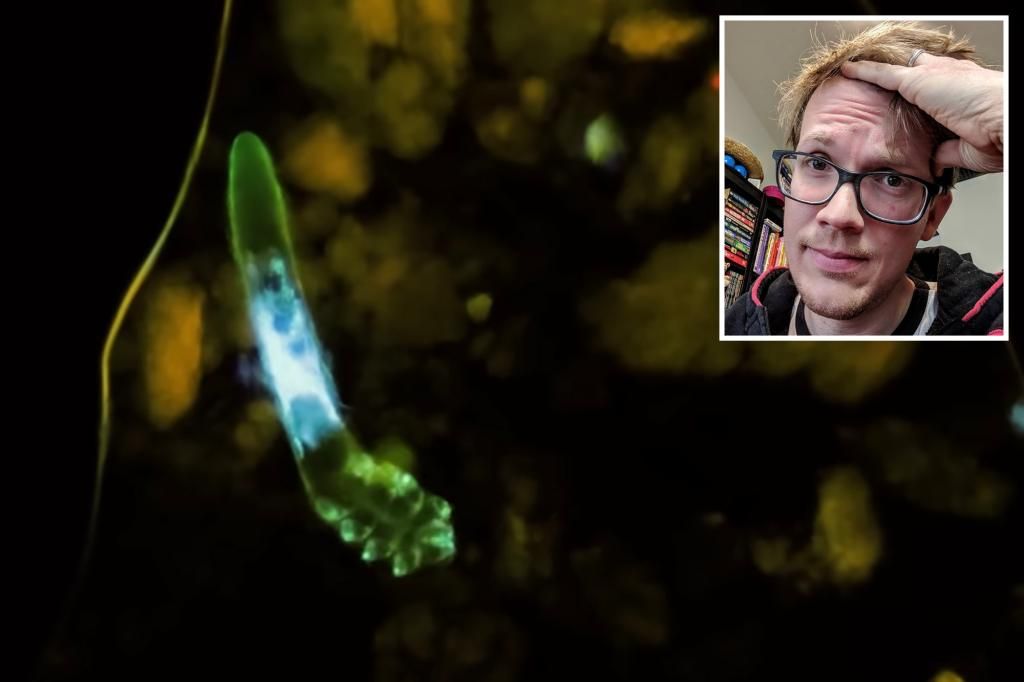Invisible creatures are having sex on your face - while you sleep
You mite need to brace yourself for this one.
There are small mites called Demodex that live on most people’s faces — and they mate in the nighttime.
And a horrifying new video is showing and breaking down the ins and outs of these creepy, crawly creatures.
A clip from the YouTube channel “Journey to the Microcosmos” shows footage taken by videographer and author of the book, “The Hidden Beauty of the Microscopic World,” James Weiss, after he found a black speck on his head.
This black speck turned out to be a Demodex mite, which are less than one millimeter in length and have eight little legs.
There are two different types of the mite: Demodex folliculorum, which inhabit our hair follicles and eat skin cells, and Demodex brevis, which live on our faces and near our sebaceous glands and eat the oil secreted from human skin, according to the Cleveland Clinic.
During the day, they hang out inside our pores, and at night, look for other mites on our face to mate with.
There are tiny mites living on your face called demodex. Journey to the Microcosmos/YouTube
At night, they mate on your face. Journey to the Microcosmos/YouTube
“When they are done, they head back to your pores to lay their eggs,” explained the show’s host, Hank Green.
Green said that the adult Demodex will lay around 20 to 24 eggs in your hair follicles, and within about three to four days, the young ones will hatch.
“Their lifespan will end a few weeks later, at which point the dead mites will decompose in your follicles or sebaceous glands, turning the tiny pockets of your skin into little mite graveyards,” Green stated.
However, although this all may sound alarming, the mites are harmless and are found on pretty much everyone.
“But here’s the thing, we pretty much all have them,” Green explained in the clip. “If you’re watching this video, you probably have Demodex living on your face. And if you don’t now, you will eventually.”
They were first discovered in 1841 by two scientists who couldn’t quite figure out what they were, according to Discover Magazine, and were first formally studied in 1842, by a German scientist named Gustav Simon.
Demodex are classified as arachnids, which are closely related to insects like spiders and ticks, according to the Cleveland Clinic.
Most everyone has these mites living on their face, according to scientists. Journey to the Microcosmos/YouTube
A video about Demodex was posted on a YouTube channel called “Journey to the Microcosmos,” hosted by Hank Green. Hank Green/Facebook
These mites are typically spread through “physical contact,” according to Green, but he also cited a 2015 study that found these mites are passed down from family member to family member over generations.
“They’re not dangerous in a broad sense because we all have them and most of us seem to be cohabiting quite well with them,” Michelle Trautwein, an entomologist at San Francisco’s California Academy of Sciences, told NPR in 2019.
“We mostly share them within family units, and it seems like you are probably initially colonized soon after birth, most likely by your mother, traditionally speaking in human history.”
And since they live in our pores, they can be hard to get rid of, but very rarely, people can have a large amount of them on their faces, creating a white sheen which some doctors label as “demodectic frost.”
The creepy-crawly creatures feed on the oil on our skin. Journey to the Microcosmos/YouTube
In the future, these Demodex mites could potentially be “symbionts” with us, according to Green and a 2022 study from the journal “Molecular Biology and Evolution.”
This means that the mites and humans could become dependent on each other at some point — but that day hasn’t quite arrived yet.
According to Trautwein, Demodex and humans have long had a close connection.
“We still have this very ancient and intimate relationship, and it seems clear that we’ve had these face mite species with us for all of our history,” she said. “So they are as old as our species, as old as Homo sapiens.”
Source: New York Post


